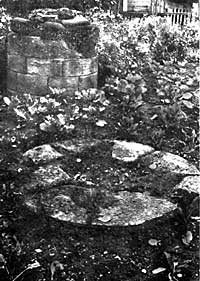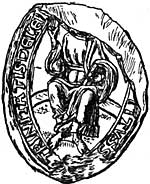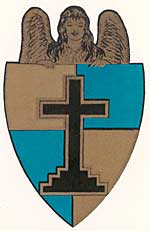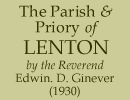< Lenton Fair | Contents | The Dissolution of Lenton Priory >
9.—THE PRIORS OF LENTON.
 |
The remains of Lenton Priory. Marked B on the plan. Part of the Calefactorium or Warming House. |
There were about 33 Priors in all. The most notable were Robert de Lexington, about 1219, Thomas of Elmham, 1414, and Nicholas Heyth, the last Prior, 1534.
Robert de Lexington was the son of a Canon of Southwell. He became a Canon himself, declined the offer of the Bishopric of Lichfield, but acted as custos of the Archbishopric of York, during its vacancy in the 10th year of King John. He performed military service and under Henry III was custodian of the Peakland Castles. He was appointed, when Prior of Lenton, one of the King's Justices Itinerant, 1219, and was rebuked by Grosseteste, Bishop of Lincoln, for hearing capital causes at Lincoln on a Sunday and for punishing the Dean of Lincoln. He died of palsy in June, 1250.
Thomas of Elmham—sometimes called Ellingham—was a monk of S. Augustine's monastery, Canterbury. First, a Benedictine monk, he became later a member of the Cluniac Order and was appointed Prior of Lenton 1414, and in 1416 was made Vicar-General to Raymund, Abbot of Cluny, for the Kingdoms of England and Scotland. Elmham was the author of several historical works of considerable importance. In the principal of these, "A History of the Monastery of S. Augustine, Canterbury," the author manifests his deep antipathy of the Lollards. This is shewn in his other book " Liber Metricus." The uncomplimentary terms in which he speaks of John Oldcastle are remarkable for their vehemence, and he even looks upon that bold reformer as of sufficient importance to be identified with the " great dragon " of the 12th Chapter of Revelation, verse 4, whose tail drew the third part of the stars of heaven." That satellite of hell, I mean, the Heresiarch of Arch-Lollard, John Oldcastle, whose stench is noted to have ascended most horribly to the nostrils of the Catholics, even like that of a dunghill."
Nicholas Heth or Heythe—the last Prior. In the 28th year of Henry VIII, Heyth was attainted of high treason, for refusing to accept certain reforming acts of the King in the latter's repudiation of the papacy and for his share in the Pilgrimage of Grace, and Heyth was hanged with 73 other monks, priors and abbots, eight monks of Lenton and four Lenton labourers. There is a tradition that he was hanged above the gateway of his Priory. "The inquisitie post morem of the possessions of Nicholas Heth late Prior of the house or monastery of the Holy Trinity of Lenton, attainted, was taken at Nottingham in 1538, the whole of the possession of the Priory being confiscated to the King." All but the Prior were probably hanged on Gallows Hill, Mansfield Road, and possibly drawn and quartered and dragged round Cow Lane (now Clumber Street).
The story of Nicholas Heyth is the saddest of all the victims of Henry VIII's rapacity. Nicholas Heyth owed his appointment to the very man who caused him to be hanged; indeed he is said to have promised Cromwell £100 for the nomination. Information in considerable detail is available in regard to the appointment of the prior in the 16th century, and from letters and papers of Henry VIII it is possible to discover some of the influences at work. In 1534 Sir Anthony Babyng-ton in a letter to Thomas Cromwell mentioned that, " my lord the Cardinal in his time," had obtained the appointment of Thomas Hobson as prior of Lenton. He went on to ask that one of the monks of Lenton should be made prior now that the office was vacant through the death of John Annesley, since he thought the house would prosper better in that case than under a stranger. It would seem that Cromwell did not pay much attention to considerations of that nature since Nicholas Heyth who obtained the vacant office, later wrote to Cromwell:
" Whereas I have promotion to the priory of Lenton near Nottingham through your favour which is not of so clear a state as I thought my predecessor had left it, I desire your favour for this poor house. And whereas I granted to Mr. Richard for your use £100; I beg you will take £60 and remit the rest till Martinmas."
It has been suspected that the bribe was not paid, but whether that be so or not Heyth was accused of treason. The villain of the plot seems to have been one Dan Hamlet Penkeryche, a disreputable monk, who had run away three times from the Priory, but on each occasion had returned and made his submission. It was he who sent information to London as to certain treasonable conversations at Lenton. Indiscreet words undoubtedly had been used, and indiscretions in those days were often expiated on the gallows. Two of the monks had railed at the King. The incident is thus described by the Sub-Prior:—
"On Easter week, in the misericorde at the board end, sate Dan John Hawghtune, and Dan Rawffe Swenson, and the former said, ' it is a marvellous world, for the King will hang a man for a word speaking nowadays.' 'Yes,' said Dan Rawffe, 'but the King of Heaven will not do so, and He is the King of all Kings, but he that hangs a man in this world for a word speaking, he shall be hanged himself in another world.'
I rebuked them for never saying a good word for the King. On the morrow, they told my master, the Prior, and he consulted with the Priory Council on the Tuesday; then was I afraid for my life, for I had heard many of the monks speak ill of the King and Queen and Lord Privy Seal, whom they loved worst of any man in the world. I trust unto God, I shall cause them to be known as they be, or else it were a great pity."
It seems that Cromwell had a spite against Heyth. King Henry was in constant need of money, and Lenton had a revenue of £329 a year, and goods worth—to those who seized them—£252.
Cromwell's grievance would seem to explain the early dissolution of Lenton
Priory, as ordinarily the richer ones were left until the last.
List of Known Priors with Approximate Dates.
Hugh?
Lambert ?
Portitus?
Humphrey, occurs temp. Henry I and about 1114 (Stephen).
Philip.
Alexander, 1189.
Peter, 1200-1214.
Robert de Lexington, 1219-1250.
Roger, 1223.
Damascenus, or Dalmasius.
Roger de Normanton, 1233-1241.
H— Hugh Bluet, 1251.
Roger Norman, 1259-1266.
Mathew, 1269.
Reginald de Jora, 1289, resigned.
Peter de Siviriaco, or Siriniaco, 1281-1289.
William, 1290-1296.
Stephen, 1312.
Reginald, 1313.
Geoffrey, 1315.
William de Pinnebury, 1324.
Geoffrey, 1327.
Astorgius or Antorgius, 1336-1346.
Peter de Abbeville, 1355.
Geoffrey de Rochero, 1403-1407.
Richard Stafford.
Thomas of Elmham, 1414-1426.
John Elmham, 1426-1450.
John Middylburgh, 1450.
Thomas Wollore, 1458-1476.
Richard Dene, 1481-1495.
John Ilkeston, 1500-1508.
Thomas Guyllam, or Gillame, 1509-1522.
Thomas Notyngham, alias Hobson, 1525.
John Annesley, 1531.
Nicholas Heth, or Heyth, 1538 (attainted and hanged).
The Seal of Lenton Priory.
 |
An imperfect impression of the Seal of Lenton Priory is appended to the Harleian Charter. It is of a pointed oval form, in red wax, and represents our Saviour seated apparently upon a rainbow, the feet being upon an orb, to represent the world, holding in the left hand a book, closed, the right hand being raised in benediction. The inscription which is partly obliterated runs:—
(SIG)ILLVM CONTENTVS SANC(TI TRINITATIS DE L)ENTO(NA)
On the reverse side is a small counter seal, also oval, with the half figure of a monk, bearing in his right hand a sceptre terminating in a fleur-de-lis, inscribed :
"+ SIGNVM PETRI P(RIOR)IS DE LENTONA."
From government and other records gathered by Mr. Herbert Green, the following interesting item is worthy of note:—
In the Calendar of Papal Registers there appears under the date 1264 the following entry, "Mandate to the Bishop of London to publish the excommunication of the prior of Lenton and Thomas de Raley, clerk of the archbishop of York ..." This sentence of excommunication was the outcome of a remarkable attempt by the prior of Lenton to deprive the rector of S. George's, Burton-on-Trent, of his office.
The prior and convent of the Cluniac monastery of Lenton, were, it appears, patrons of the church of S. George, and for some reason the prior wished a certain Thomas de Raley to be made rector. The chief obstacle to this arrangement was that one, Bartholomew, was already established in the position. Not willing to be thwarted, the prior took the bold step of pretending Bartholomew to be dead and of presenting the church to Thomas de Raley. Bartholomew, very much alive, obtained papal letters addressed to Master John de Anagai, papal chaplain, living in England. This merely had the effect of rousing the prior to greater activity. By a feigned promise to expedite the business at his own expense, the prior persuaded John de Anagai to commit the business into his hands. With the apparent intention of obeying the papal mandate the prior of Lenton entered the church along with Bartholomew's proctor. Once they were inside the church, the prior disclosed his real intentions. While he looked on, and made no attempt to stay the violence, certain servants of Thomas de Raley stripped the proctor, robbed him of the papal letters, and killed him hard by the cemetery.
A Legend of Lenton.—Under this title, a writer, signing himself "Fitz-Green," contributed the following lines (in obvious imitation of the Ingoldsby Legends) to a short-lived and long forgotten local publication : The Nottingham Anthenaeum Society's Magazine—in 1861: —
William de Peverill, waxing old, Began to think of his latter day; He'd been a warrior stout and bold, In wealth and pleasure had revelled and rolled, But health and strength were fleeting away. And as he backward looked, at times, Long catalogues of sins and crimes, Like Satan's charts appeared to his view,— And they made him feel queer, So he called Father Pierre, His Confessor—as elderly gents would do! Father Pierre Came up the stair— And he started to see my lord looking so queer! "O! Father," he cried, "I'm a long way from young, My health is quite shattered, my nerves are unstrung; And, to tell you the truth, there are some things I fear I have done in this life, which will look rather queer When examined above—If I ever get there!"— And he heaved a deep sigh, "I could bear to be blamed; But you know, mon cher p'ere, it won't do to be damned!" "Why son, dear son, 'twere a task forsooth, To atone by prayer, all your sins from youth! You must shew your repentance by deeds, as well As words, if you'd save your soul from Hell!— And the best of all ways to obtain your desire, Is to build up an Abbey, with me for its Prior— Do this, my son, and allay your fears, And we'll send you to Heaven with masses and prayers; Sir Roger de Bush has built one at Blythe, And now he can scorn the grim leveller's scythe; And another is building at Worksop, we know, By that honest knight, Sir William Lovetot:— No longer they mope, As if cursed by the Pope, Or look sad as a thief condemned to the rope; But cheerful and gay are they now for they know They have cheated old Nick By a savory trick,
That has saved both de Bush and William Lovetot.
So if you, my dear son, would escape from the fire,
Build a church as they've done, and let me be the Prior!"
"I will, I will!" cried Peverill. "See
I swear by the Holy Trinity,
And a noble Abbey it shall be!—
Go fetch a clerk, and we'll seal and sign,
This very morn before we dine,
And I hope 'twill calm this soul of mine!—
For to tell you the truth, I have felt a long while,
A fit of repentance, or—hem !—else of the bile;
And if now I'm not eased, it will be very shabby,
For you know it's no joke to found a great abbey."
The Clerk he came, and the deed was drawn
By the father and he that very morn;
Clear and concise were the words he drew—
(No abstracts were needed for Titles so new.)
It merely recited, That William de P.,
For the love of the Holy Trinity,
For the rest of his soul, and the souls of his kin,
Did grant and convey the lands mentioned within,
To found and endow a place fit to be seen,
For the worship of God, on the banks of the Lene.
William Peverel, we are told in the narrative, being thus conjured by his spiritual adviser, and in articulo mortis, proceeded to endow his religious house in a fashion to rejoice his confessor's heart (and pocket):—
He gave it manors so many, that
The list appears a parable; And borders lean, and villains fat,
To cultivate the arable. The right to toll, the right to tax, And the
right to hang the Anglo-Sax., To prison their bodies, and scourge their
backs, (They were fond of making impressions in " whacks ").
Nearly all that His Honour could grab, he Presented, we're told to Lenton
Abbey!
Soon, rising from the banks of the Lene,
A stately edifice was seen,
A very noble pile, I ween;—
And a host of monks, both big and puny,
Were imported there, from the Abbey of Cluny;
But Father Pierre had his desire, he
Was "a priori," chief of the Priory.
Sweetly the bells of Lenton rang,
And breezes bore their merry clang,
Like the laughter of angels throughout the dells,
The ring-a-ding-dong of Lenton bells.
And the fathers sang "Hosanna!"
In an edifying manner,
And, though I didn't see 'em,
The "Gloria" and "Te Deum!"
And people went to church, Forsaking all things evil,
And to be left in the lurch Raised anger in the Devil! The Devil looked black, and the Devil looked blue, And he scratched his head in doubt; At last he cried "O! what can I do, To serve these beggars out!" And then he smiled with a wicked grin, "I'll smash their precious monkery in, And a precious storm I'll be brewing, For if here they stop, I must shut up shop, For my business is going to ruin!" He hied him away to Castleton, Atop of the Peak he went, And he seized a huge block of sandstone rock, Which from the Peak he rent; Cries he "Ho! ho! 'tis a famous throw Hence into the distant Trent, And Lenton Abbey is danger proof If it stands this trifle upon its roof." Away from his hands the huge rock flew As easily as a brick-bat;
And he shouted, "You poaching shaven crew, Confound your bodies, take that!"
* * * * *
In the turret, gently swinging,
The Lenton bells were sweetly ringing, And the mellow music floated through
the air;
And the monks were just beginning
Their holy vespers to be singing, And thwarted Sathanas with their prayer.
And the spell of holy music met the stone,
As it speeded like a meteor through the air, For, when over Bramcote Hills
it tumbled down,
And to prove the legend true, 'tis still there I
Yes, there it is, and now 'tis known To each one as the "Hemlock Stone." Satan,
chagrined, for many centuries after,
Did let the pious brotherhood alone;
But when King Harry sat upon the throne He played the Devil with each wall
and father.
When all its great possessions he did grab, he
Beat the Black Prince in smashing Lenton Abbey!"
So runs the Ingoldsby-like version! It is not often that one may catch Mr. Godfrey (our great authority on Lenton) and other standard local historians napping, but Fitz-Green— the writer of the foregoing—appears to have enjoyed access to certain detailed documents not known to other writers. Fitz-Green, we observe, did not date or place his valuable account, and we can only speculate—in the dryasdust fashion of an antiquary—as to its source. The inference is that he was ashamed to state his address, for we are driven to the assumption that he probably had a close acquaintance with, if not a warm friendship for the gentleman whose reprehensible conduct he so minutely describes. We doubt the existence of bland old Father Peter, although we cannot prove the negative view. As to the conduct of Henry VIII, there is not room to doubt. The great iconoclast swept the wealth of Lenton into his net.
Reprinted from the Nottingham Weekly Express.
The Arms of Lenton Priory.
 |
The Arms of Lenton Priory are described in Tongs "Visitation of the Northern Counties," in 1530, as follows:—
"The Armes of the House ys golde and azure quarterly, over all a playn crosse sable, borderid golde."
No earlier example of the arms has been found.
< Lenton Fair | Contents | The Dissolution of Lenton Priory >
